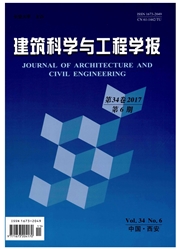

 中文摘要:
中文摘要:
建立考虑桥台-土、桩-土相互作用的整体式无缝桥有限元分析模型,并选取下部结构形式、温度作用、台后填土性质以及桥梁跨径为研究参数,对比分析了采用不同下部结构形式的整体式无缝桥受力特征。结果表明:下部结构刚度越大,其对上部结构的约束作用越强,桥梁纵向整体性更明显,但对主梁梁端和桥台的受力越不利;当下部结构刚度较大时,温度对桥梁内力和变形的影响更明显;随着桥梁跨径的增大,整体温度作用的影响逐渐成为温度作用中的主要因素;当下部结构采用矮桥台与桩基础时,台后填土密实度对梁端和桥台弯矩以及主梁轴力的影响不明显;当采用墙式桥台时,随着台后填土密实度的增大,温度作用下主梁轴力会快速增大;随着桥梁跨径的增大,整体式无缝桥的内力不断增大,且当采用刚度较大的下部结构时增大的速率更快;若以桥台在正常使用极限状态下的混凝土裂缝宽度为控制目标,应对整体式无缝桥的最大桥长进行限制,且下部结构刚度越大,最大桥长的限制越严格。
 英文摘要:
英文摘要:
Considering the abutment-soil interaction and models of integral abutment bridges were established. pile-soil interaction, the finite element The parameters including the types of substructures, temperature action, backfill properties and bridge length were selected, and the mechanical characteristics of integral abutment bridges with different substructures were studied. The results show that the substructures with larger stiffness provides stronger restraint to superstructures and the longitudinal structural integrity of the bridge is more obvious, but the stress states of girder ends and abutments are worse. The effects of temperature action on the internal forces and deformations of bridges are more obvious if the stiffness of substructures is larger. The influence of the uniform temperature effect becomes the main factor of temperature action with the increase of bridge length. When the short abutment and pile foundation are used, the effects of backfill density on the bending moment of girder ends and abutments, and the axial force of girders are not obvious. When the wall-type integral abutments are used, with the increase of backfill density, the axial force of main beam will increase rapidly under temperature action. The internal forces of the integral abutment bridges increase with the increase of bridge length, and the increasing rate is faster when the substructures with larger stiffness are used. If the widths of concrete cracks are chosen as the control target when the abutments are under serviceability limit state, it is suggested that the bridge length should be limited, and the limit of maximum bridge length is more strict when the stiffness of the substructure is greater.
 同期刊论文项目
同期刊论文项目
 同项目期刊论文
同项目期刊论文
 期刊信息
期刊信息
